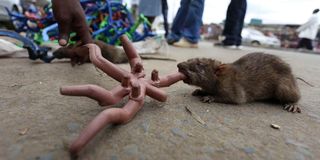How climate change attracted unwanted guests to Ndaragua

A rat trapped on a trapping device of sale at Nairobi's Gikomba Market.
What you need to know:
- The high number of rodents is attributed to a conducive breeding environment.
- Ndaragua normally has dry weather with relatively cool temperatures at night.
For the first time in decades, farmers in Ndaragua, Nyandarua County, are expecting a bumper harvest, thanks to favourable climate conditions.
But this blessing has brought a unique challenge. There is a surge in giant rodents invading farms and homes, raising concerns among residents with farmers complaining they have not seen such a phenomenon in years.
The high number of rodents is attributed to a conducive breeding environment with agrovet outlets recording high sales of chemicals meant to eliminate rats and even snakes.
Like many regions, Ndaragua is also affected by climate change, which has led to variations in rainfall patterns over the years with this variability impacting agriculture and water availability in the area.
Ndaragua normally has dry weather with relatively cool temperatures at night throughout the year and a moderate climate.
“We have never witnessed such a huge population of rodents. It is impossible to sleep at night as they are so big that one can mistake them for a criminal walking on the roofs and ceilings or that the house is under attack as they scavenge for food and knock down household items,” said Ms Mercy Mwangi.
Joel Mwaniki from Leshao Pondo, Umoja Mbuyu village, called for government intervention to address the rat menace.
“The rats are so many. Every morning I collect an average of five to 10 huge rats killed by the poison. We spend a lot of money on poison, but the rodents won't end," said Mwaniki.
At Kidipa Village, families also opt to burn the rodents collected after poisoning them at night.
“The heavy stench from throwing them in pit latrines or garbage sites was too much, polluting the air. We have opted to collect and burn them. They are a big menace breeding in the farms and pastures. It’s a blessing to have enough pastures for our livestock, but the tall grass forms breeding areas for the rodents. They are also destroying crops in the farms,” said Mr Wanjohi wa Mary while asking for government intervention on how to eliminate them.
In many areas where livestock farmers depend on pasture, there is a heavy canopy of grass due to improved rains this year, with farmers expecting a bumper harvest.
This is a significant change for an area where farmers were giving up on farming after years of unrewarding efforts caused by unpredictable weather.
“The weather is in our favour this year. If this continues, we expect a good maize harvest. It will be the first time farmers will be harvesting in more than five years of relying on food donations. The promising harvest and conducive weather are attracting back farmers who had abandoned their farms for greener pastures,” said village elder Jackson Mwaura.
Climate change and environment experts have indicated that climate change is affecting agricultural patterns globally, and Ndaragua is no exception.
“The scenario where maize dries at the flowering stage due to inadequate rainfall in June/July is concerning and may continue unless there are significant shifts in weather patterns,” said Mr Mwanzia Kyambia, Nyandarua County climate change director.
Mr Kyambia stressed the importance of understanding and monitoring critical weather patterns for Ndaragua farmers.
He advised farmers to monitor long-term changes in the onset and duration of rainy seasons, temperature trends, and drought frequency.
"If the rainy season is consistently delayed or shorter, it might be beneficial to adjust planting schedules or select drought-resistant crops,” Mr Kyambia said.
He said higher temperatures can increase evaporation rates, reducing soil moisture and affecting crop growth. He asked the growers to note temperature trends and consider shade-providing practices or irrigation.
“Understanding the frequency and severity of droughts can help in planning. Strategies like rainwater harvesting, soil moisture conservation, and selecting drought-resistant crop varieties can mitigate impacts,” said the climate change director.
He also suggested utilising short-term and seasonal weather forecasts and collaborating with local agricultural extension services for accurate information.
Maintaining soil health through practices such as mulching, cover cropping, and organic amendments can improve water retention and crop resilience to dry spells.
Exploring alternative crops like sorghum, millet, and certain legumes, which may perform better under drier conditions, is also recommended according to the expert.
Agroforestry, which integrates trees and shrubs into farming systems, can provide multiple benefits, including shade, improved soil moisture, and additional income sources.
“By understanding and adapting to these patterns, farmers in Ndaragua can better cope with the challenges posed by climate change and improve the sustainability of their farming practices,” added Mr Kyambia.





